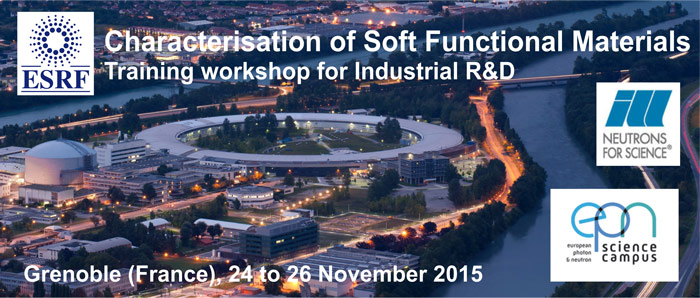- Home
- Events
- Conferences and Workshops
- 2015
- Characterisation of soft functional materials for industry
Characterisation of soft functional materials for industry
Training workshop for Industrial R&D Scientists and Engineers
24 to 26 November 2015, EPN Campus, Grenoble

Consumer products based on soft functional material often exhibit macroscopic properties which are strongly dependent on their micro- and nano-structures extending over multiple length scales. Synchrotron and neutron scattering are complementary techniques ideally suited for probing these multilevel structures and deliver valuable and often unique information to the R&D scientist or engineer.
Based in Grenoble (in the French Alps), the European Synchrotron Radiation Facility (ESRF, www.esrf.eu) and the Institute Laue Langevin (ILL, www.ill.eu) are world-leading synchrotron X-ray and neutron sources, respectively. We run a suit of advanced instruments with a wide range of sample environments mimicking industrial processing conditions and operated by a dedicated staff of experts, on hand to advise users. Fast and flexible access for proprietary experiments with a modular, personalised service is offered to our industrial clients.
This workshop presents a unique opportunity for industrial scientists to get hands-on practical experience of the various X-ray and neutron techniques available at the ESRF and the ILL under the close guidance and tuition of our scientists. Specific problems directly concerning the R&D scientist / engineer will be treated in group sessions or confidentially through one-to one meetings.
The workshop will be introduced by invited long-standing users from industry who will share their personal experience of carrying-out important research at the ESRF and the ILL.
Date: 24 to 26 November 2015 (noon-to-noon, 2 nights)
Venue: European Photon & Neutron Science Campus (EPN), hosted by: ILL – Neutrons for Science and ESRF – The European Synchrotron
71 avenue des Martyrs, 38000 Grenoble, France
www.epn-campus.eu
Registration: Closing date 31 of October 2015. To register, please send a message to the organisers: sfm-workshop@esrf.fr
Fees: No fees apply for registrations before 31 October 2015. The workshop includes coffee breaks, lunches, dinners and accommodation in the guesthouse on the EPN campus.
Contacts:
Dr Michael Sztucki (contact by email)
Dr Lionel Porcar (contact by email)
Covered topics:
(main focus will be determined by the interests of the participants)
Small Angle Scattering (SAS) techniques (using Neutrons or X-rays) help researchers in various scientific fields like physics, chemistry, biology, materials sciences, and engineering to gain insight into a variety of research questions for structure determination of systems from atomic or molecular to mesoscopic scales.
Systems to be studied by SAS of X-rays and Neutrons extend over a wide range such as determining the microstructure and phase behaviour of polymers, liquid crystals, colloids, membranes, surfactants, biomolecules, and complex systems like detergents, food products, pharmaceuticals, etc.
- Small and Wide Angle X-ray Scattering (SAXS/WAXS) as well as Small Angle Neutron Scattering (SANS) instruments at ESRF and ILL offer a high photon / neutron flux and give access to a wide range of length scales from a few Angstroms up to micron scale.
- Combination of X-ray and neutrons provide unique tools to resolve internal structure and reveal details otherwise hidden.
- Scanning microbeam SAXS/WAXS and single micro-crystal/fibre diffraction (µXRD) allows the local nanostructure of very small objects to be tested, like micro-specimens of composite materials, micromechanical parts, polymer fibres, micro-fluidics, and biological specimens with micro- or nanometric real space resolution.
- Grazing Incidence Diffraction/Scattering (GID/GISAXS) techniques give access to nanoscale structure of nano-structured complex fluids at interfaces, films, biological membranes, etc.




